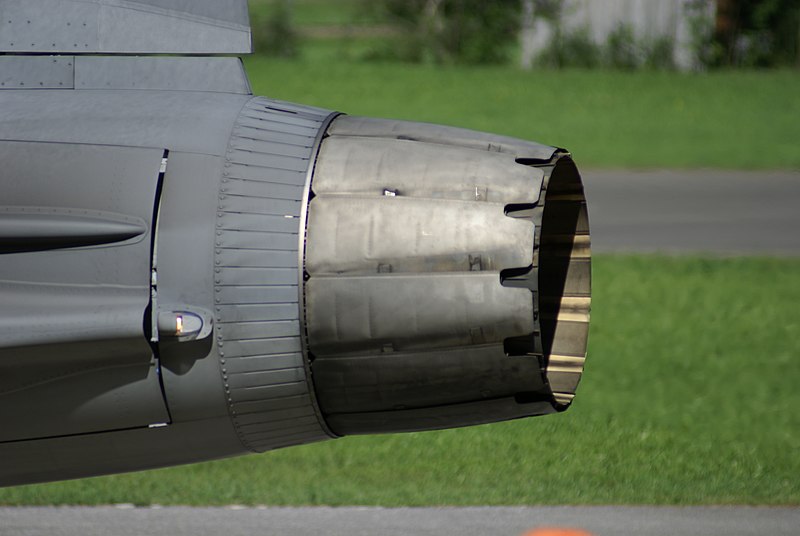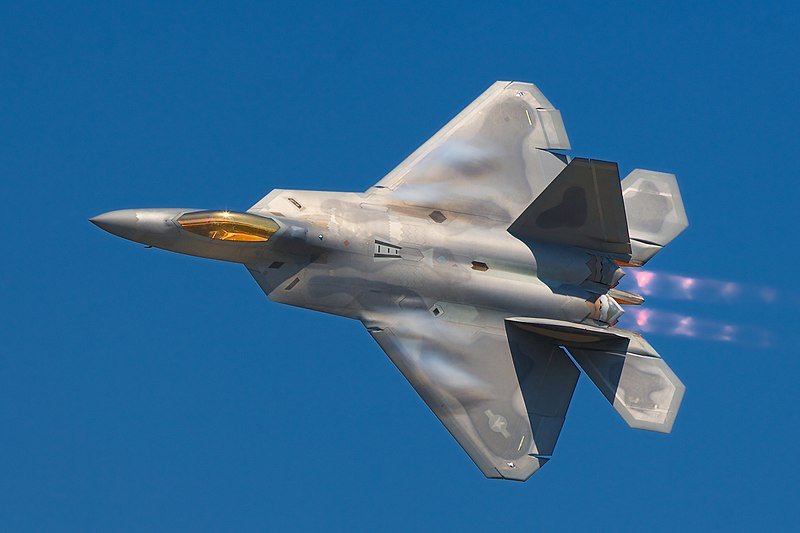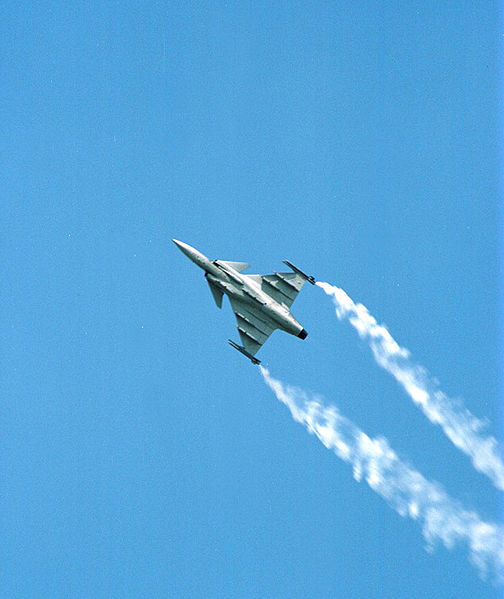Saab Aerospace's Gripen fighter continues to be the single application for Volvo's RM12 engine. By the end of 2010, the Gripen had a 23-aircraft backlog. Based on current delivery schedules, this backlog will push production into 2013.
In the absence of any new orders, Saab will be concentrating on upgrading the Gripens of Sweden's Air Force to the C/D standard. Saab is offering an updated variant of the fighter (Gripen NG) for fighter competitions in Brazil, Bulgaria, Denmark, Greece, India, the Netherlands, Romania, Slovakia, and Switzerland.
One of the elements of the Gripen NG program is a higher thrust engine. Saab has been testing a 22,000-lbst GE F414G in place of the RM12. The higher thrust gives the Gripen supercruise capability and a higher weapon payload and fuel capacity, thereby increasing range. The other elements to the NG program are an upgraded radar and avionics.
Once production of the RM12-powered Gripen has ended, we expect Volvo to support the existing fleet by continuing to produce engine modules and spares.
Snecma M88 Faces Cuts in Dassault's Rafale Program
The Snecma M88's fate is based on the Dassault Rafale fighter, which is the single application for the engine. Through December 2010, the French government ordered a total of 180 Rafales, but in 2009 Dassault announced its production rate would drop from 14 aircraft annually to 11, and that this decline would continue through 2016. This move was made to slow the delivery of the French military's new Rafales, which are competing with the existing Mirage fleet, 50 of which are undergoing a midlife upgrade. The upgrade of the Mirages may mean a reduction in the new fighter requirement to 250 aircraft from the current 294.
To date, the French government has ordered 180 aircraft; in December 2009, the last multiyear purchase contract known as Tranche 4 was announced. It is expected that Tranche 4 will cover aircraft production from 2013-2017. These aircraft will have the upgraded M88-4E engine (formerly known as the TCO Pack), which incorporates a modified high-pressure compressor and turbine. The goal of the durability development program has been to extend the engine's service life and time between inspections. Production of the M88-4E is expected to begin late in 2011.
Eurojet EJ200 Supports Eurofighter Program
The Eurojet EJ200 continues in production for its single application, the Eurofighter Typhoon. Of the three planned production batches, the first two cover the first 384 aircraft; tranche 1 production ended in 2008 and tranche 2 will continue into 2013. Tranche 3 has been split into A and B groups, with the 3A group accounting for 112 aircraft.
The question is what will happen with tranche 3B, as defense budgets in the four partner countries are under pressure and a reduction in aircraft purchases may be inevitable. The signing of the tranche 3B contracts is due to occur in 2011, and at the start of the year the prospects of an order were rather grim. As such, production of the 3A aircraft will be completed in 2016-2017.
The Eurofighter has been a slow seller on the export market. The initial order for 72 aircraft from Saudi Arabia will probably have no follow-up, as the kingdom announced plans to order 84 new F-15Es. India is still a promising potential customer with its 126-aircraft requirement, and Turkey may need up to 100 aircraft to replace its 120 F-4s. Japan may take a serious look at the Typhoon for its 50-aircraft requirement, as efforts to purchase Lockheed Martin's F-22 have been blocked by the U.S. Congress.
Eurofighter and its partners have been studying the idea of a naval variant of the Typhoon. In addition to the structural strengthening required to modify the aircraft for carrier operations, Eurofighter believes a thrust-vectoring version of the EJ200 would allow for the necessary lower approach speeds and resultant lower structural landing loads. The company says thrust vectoring could be integrated into the aircraft's advanced flight control system
http://www.defencetalk.com/volvo-rm12s-future-depends-on-gripen-ng-success-36182/
جريبين
Saab JAS 39 Gripen
إستمرار إختبارات المحرك الجديد للمقاتله
وهو محرك ذو قدرة دفع أقوى من المحرك الحالى مما سيعزز
قدرة المقاتله فى حمل الأسلحه وزيادة مدى عملها


وفى ظل عدم وجود أى طلبيات جديده لشركة ساب
تعمل الشركه حاليآ على تطوير مقاتلات جريبين الخاصه بسلاح الجو السويدى
لرفعها إلى معيار C/D standard
ومن المعروف أن جريبن خرجت من المناقصه الهنديه ومازالت مشاركه فى المناقصه البرازيليه
وتعرضها شركة ساب على رومانيا وسويسرا واليونان وهولندا والدانمارك وبلغاريا
الرافال
Dassault Rafale

سينخفض إنتاج داسو من 14 مقاتله رافال فى العام إلى 11 مقاتله وذلك
لأن سلاح الجو الفرنسى قرر تخفيض عدد 50 مقاتله رافال من إجمالى العدد المطلوب
وذلك لسببين
هو وجود منافسه للرافال وهى الميراج التى يتم حاليآ إجراء تطوير منتصف العمر على 50 مقاتله
من أسطول الميراج الحالى
والسبب الأخر هو إنتظار تطوير محرك الرافال Snecma M88
إلى M88-4E engine

وكان سلاح الجو قد طلب 180مقاتله فى ديسمبر 2009
وهى الرافل المعروفه f4 سيتم إنتاجها ما بين 2013 إلى 2014
التايفون
Eurofighter Typhoon
إستمرار دعم المحرك Eurojet EJ200 للمقاتله

والذى تم إستخدامه فى 384مقاتله من الترانش الأول تم إنتاجها لغاية عام 2008
ويدعم الترانش الثالث التى سيتم إنتاجها إلى عام 2013
وبالنسبه للترانش الثالث تم تقسيمه إلى طرازين
Tranche 3A و Tranche 3B
بالنسبه Tranche 3A تم طلب 112 مقاتله
ولكن السؤال الحالى ماذا سيحدث للترانش Tranche 3B
فى ظل خفض ميزانيات الدفاع فى الدول الأربع المنتجه للمقاتله
ومن المقرر التوقيع على عقود هذا الترانش فى العام الحالى
ومن المقرر أن يتم الإنتهاء من إنتاج Tranche 3A
فى عام 2016 و 2017
بالنسبه لسوق التصدير
من المعلوم أنه تم عقد صفقه مع السعوديه بعدد 72 مقاتله
وربما لن تزيد السعوديع على هذا العدد
وذلك لأنها طلبت 84 مقاتله new F-15Es

الهند
مازالت المقاتله فى المنافسه على صفقه تقدر ب126 مقاتله
تركيا
قد تحتاج لمائة مقاتله لإحلالها مكان الفانتوم القديمه

اليابان
تفكر جديآ فى شراء 50مقاتله وذلك بعد رفض الكونجرس بيعها
المقاتله f22

وشركة يورفايتر تفكر فى الطراز البحرى للمقاتله
بالإضافه لتعزيز هيكل المقاتله
والتوجه للإصدار thrust-vectoring version من المحرك EJ200
وهذا خبر أخر عن عرض الشركه على الهند المشاركه فى الطراز البحرى للتايفون
مع الدول الأربعه مع المواصفات التى سيكون عليها الطراز البحرى
n anticipation of winning the Indian Air Force's $10.4 billion tender for 126 combat jets, European consortium EADS has offered India a choice to pioneer a project for a naval version of the Eurofighter Typhoon that is in the fray in what is being described as the "mother of all defence deals".
Typhoon's competitor in the medium multi-role combat aircraft (MMRCA) tender, the French firm Dassault's Rafale, already has a naval version that is operational on France's lone nuclear-powered aircraft carrier Charles de Gaulle.
Officials of BAE Systems, one of the four partner companies in EADS for the Typhoon programme, told IANS during a visit to their RAF Warton production facility in Britain recently that India can exercise the choice of being a partner nation and leading the programme for the carrier-borne version of the aircraft if it wins the MMRCA tender. At present, Britain, Italy, Spain and Germany are partners in the Typhoon programme.
According to the BAE Systems officials, the Typhoon, which is a shore-based combat jet, has the potential to be a carrier-borne aircraft, provided a few modifications are made to the aircraft itself, essentially in a ski-jump take-off configuration due to the thrust-vectoring 90 kN (kilo Newton) engine that powers it.
Among the changes, it identifies strengthening of the undercarriage of the aircraft to assist in hard landings on a carrier's deck, fitting a carrier hook for arrested landings, and a good paint coating to help it withstand the vagaries of nature at sea.
The choice of the Typhoon for the Indian Navy the officials said, will complement the experience of operating the British Sea Harrier vertical-landing carrier-borne aircraft on board its lone aircraft carrier, INS Viraat, for over two decades now. Of the nearly 30 Harriers India had got for INS Viraat, only about 10 are left in service, with the rest lost in air crashes.
The offer has been made keeping in mind the Indian Navy's request for information issued in 2009. But the Indian Navy itself is not very amused with the offer.
First, according to officials, the Indian Navy plans to induct the Russian-built Admiral Gorshkov or INS Vikramaditya in the next couple of years. This warship will deploy Russian MiG-29K naval fighter jets and for this, the vessel is being reconfigured into a ski-jump take-off but arrested landing (STOBAR) mode at the Sevmash shipyard in Russia.
The same aircraft will be operated from the flight deck of India's indigenous aircraft carrier, under construction at the Cochin Shipyard, when it is inducted in the middle of this decade. Hence the Indian Navy has placed a total order for 45 MiG-29Ks for the two carriers from Russia.
For the future, the navy wants the Defence Research and Development Organisation's Tejas light combat aircraft's naval variant to fructify. If it does, then it may be the future carrier-borne aircraft of the navy for its two more indigenous aircraft carriers planned for construction at the Cochin Shipyard. But that decision is a long shot as it stands today, according to senior naval aviation officers.
But here is where the EADS, and BAE Systems in particular, is hopeful and is pitching the Typhoons as a powerful STOBAR platform for the future indigenous aircraft carriers of India
http://www.defencetalk.com/india-given-choice-to-pioneer-naval-typhoon-jet-36086/


